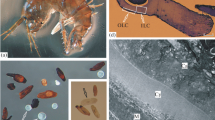Abstract
Scanning and transmission electron microscopy were used to study the invasion of mouse small-intestinal epithelium by sporozoites ofEimeria papillata. Some mice received oocysts by gavage and others received either sporocysts or sporozoites by direct injection into the small intestine. The highest concentration of invaded cells were found in ligated intestinal tissues studied at 5–45 min after the inoculation of sporozoites. Sporozoites actively invaded anterior end first, which resulted in extensive damage to the host cell. Such cells showed disrupted microvilli; protuberances of cytoplasm into the lumen, apparently the result of a disrupted plasma membrane; vacuolization of the cytoplasm; and damage to the mitochondria. These damaged cells were rapidly vacated as the sporozoite moved laterally into one or more adjacent intact host cells without entering the lumen. It is suggested that the host cell initially entered from the lumen becomes so severely traumatized that the parasite of necessity enters an adjacent cell as a prelude to further development. Various aspects of host-cell invasion by coccidia and malarial parasites are reviewed.
Similar content being viewed by others
References
Aikawa M, Miller LH, Johnson J, Rabbege J (1978) Erythrocyte entry by malarial parasites. A moving junction between erythrocyte and parasite. J Cell Biol 77:72–82
Aikawa M, Miller LH, Rebbege J, Epstein N (1981) Freeze-fracture study of the erythrocyte membrane during malarial parasite invasion. J Cell Biol 92:55–62
Alberts B, Brag D, Lewis J, Raff M, Roberts K, Watson JD (1989) Molecular biology of the cell, 2nd edn. Garland, New York
Augustine PC (1985) Host-parasite interaction at the cell surface. In: St John J, Berline E, Jackson P (eds) Frontiers of membrane research in agriculture. Rowman and Allenheld, Totowa, Maryland, pp 461–466
Augustine PC (1989) TheEimeria: cellular invasion and host-cell parasite interactions. In: Yvore P (ed) Coccidia and intestinal coccidiomorphs. Collogues de INTRA 49, Tours, France, pp 205–215
Chobotar B, Scholtyseck E (1982) Ultrastructure. In: Long PL (ed) The biology of the coccidia. University Park Press, Baltimore, pp 101–167
Danforth HD, Chobotar B, Entzeroth R (1984) Cellular pathology in mouse embryonic brain cells following in vitro penetration by sporozoites ofEimeria papillata. Z Parasitenkd 70:165–171
Danforth HD, Entzeroth R, Chobotar B (1992) Scanning and transmission electron microscopy of host-cell pathology associated with penetration byEimeria papillata sporozoites. Parasitol Res 78:570–573
Doran DJ (1973) Cultivation of coccidia in avian embryos and cell culture. In: Hammond DM, Long PL (eds) The coccidia:Eimeria, Isospora, Toxoplasma and related genera. University Park Press, Baltimore, pp 183–252
Doran DJ (1982) Behavior of coccidia in vitro. In: Long PL (ed) The biology of the coccidia. University Park Press, Baltimore, pp 229–285
Dubremetz JF (1988) Motility and penetration. In: Mehlhorn H (ed) Parasitology in focus — facts and trends. Springer, Berlin Heidelberg New York, pp 188–196
Entzeroth R (1985) Invasion and early development ofSarcocystis muris (Apicomplexa: Sarcocystidae) in tissue cultures. J Protozool 32:446–453
Hammond DM, Chobotar B, Ernst JV (1968) Cytological observations on sporozoites ofEimeria bovis andE. auburnensis, and anEimeria species from the Ord kangaroo rat. J Parasitol 54:550–558
Jensen JB, Edgar SA (1976) Possible secretory function of rhoptries ofEimeria magna during penetration of cultured cells. J Parasitol 62:988–992
Jensen JB, Edgar SA (1978) Fine structure of penetration of cultured cells byIsospora canis sporozoites. J Protozool 25:169–173
Jensen JB, Hammond DM (1975) Ultrastructure of the invasion ofEimeria magna sporozoites into cultured cells. J Protozool 22:411–415
Joyner LP (1982) Host and site specificity. In: Long PL (ed) The biology of the coccidia. University Park Press, Baltimore, pp 35–62
King CA (1988) Cell motility of sporozoan protozoa. Parasitol Today 4:315–319
Long PL, Speer CA (1977) Invasion of host cells by coccidia. In: Taylor AER, Muller R (eds) Parasite invasion. Blackwell, London, pp 1–16
Michel R, Schupp K, Raether W, Berther FW (1980) Formation of a close junction during invasion of erythrocytes ofToxoplasma gondii in vitro. Int J Parasitol 10:309–313
Mitchell GH, Bannister LH (1988) Malaria parasite invasion: interactions with the red cell membrane. CRC Crit Rev Oncol Hematol 8:255–310
Nichols BA, O'Connor GR (1981) Penetration of mouse peritoneal macrophages by the protozoonToxoplasma gondii. Lab Invest 44:324–335
Perkins ME (1989) Erythrocyte invasion by the malarial merozoite: recent advances. Exp Parasitol 69:94–99
Roberts WL, Hammond DM (1970) Ultrastructural and cytological studies of sporozoites of fourEimeria species. J Protozool 17:76–86
Roberts WL, Speer CA, Hammond DM (1971) Penetration ofEimeria larimerensis sporozoites into cultured cells as observed with light and electron microscopes. J Parasitol 57:615–625
Russell DG (1983) Host cell invasion by Apicomplexa: an expression of the parasites' contractile system? Parasitology 87:199–209
Russell DG, Sinden RE (1981) The role of the cytoskeleton in the motility of coccidian sporozoites. J Cell Sci 50:345–349
Russell DG, Sinden RE (1982) Three-dimensional study of the intact cytoskeleton of coccidian sporozoites. Int J Parasitol 12:221–226
Scholtyseck E (1973) Ultrastructure. In: Hammond DM, Long PL (eds) The coccidia:Eimeria, Isospora, Toxoplasma and related genera. University Park Press, Baltimore, pp 81–144
Scholtyseck E, Chobotar B (1975) Electron microscope observations concerning the penetration of a host cell byEimeria ferrisi in vivo. Z Parasitenkd 49:91–94
Silva SRL, Meirelles SSL, Souza W de (1982) Mechanism of entry ofToxoplasma gondii into vertebrate cells. J Submicrosc Cytol 32:19–39
Speer CA (1983) The coccidia. In: Jensen JB (ed) In vitro cultivation of protozoan parasites. CRC Press, Boca Raton, Florida, pp 1–64
Werk R (1985) How doesToxoplasma gondii enter host cells? Rev Infect Dis 7:449–457
Author information
Authors and Affiliations
Rights and permissions
About this article
Cite this article
Chobotar, B., Danforth, H.D. & Entzeroth, R. Ultrastructural observations of host-cell invasion by sporozoites ofEimeria papillata in vivo. Parasitol Res 79, 15–23 (1993). https://doi.org/10.1007/BF00931212
Accepted:
Issue Date:
DOI: https://doi.org/10.1007/BF00931212




